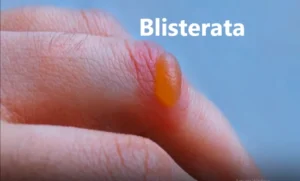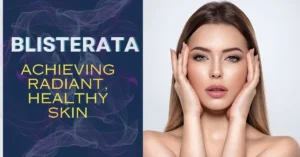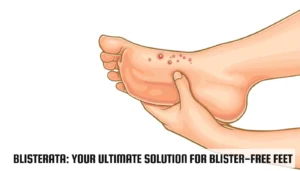Blisterata is a term used to describe a type of blistering that can occur on the skin. If you’ve ever had a painful, fluid-filled bump on your skin, you might have experienced blisterata. This condition happens when the skin is damaged by friction, heat, or chemicals, causing fluid to collect between the skin layers.
In this blog post, we’ll explore what blisterata is, why it happens, and how you can take care of it. We’ll also discuss some easy tips to prevent blisters from forming in the first place. Whether you’re dealing with blisterata or just want to learn more, you’re in the right place!
What is Blisterata Understanding the Basics
Blisterata is a term used to describe a type of skin blister. Blisters are small, fluid-filled bumps that can appear on the skin. They can be caused by many things, including rubbing, heat, or chemicals. Blisterata happens when the skin gets damaged and fluid builds up between the skin layers.
When you have blisterata, it’s like a tiny pocket of fluid that forms under the skin. This fluid helps protect the skin underneath and gives it time to heal. Blisters can be filled with clear liquid, blood, or pus if they get infected. Understanding what blisterata is can help you take better care of your skin.
Blisterata can appear on different parts of your body. Common places include your feet and hands, especially if you are doing activities that cause a lot of friction. For example, wearing new shoes or working out can lead to blisterata. Knowing the basics of blisterata helps you recognize and treat it properly.
Taking care of blisterata involves letting the blister heal on its own. It’s important not to pop the blister because this can lead to infection. Keeping the area clean and protected helps the healing process and prevents complications.

Common Causes of Blisterata: Why Do Blisters Form
Blisterata often forms because of friction or rubbing on the skin. This can happen from walking long distances, wearing tight shoes, or using tools that rub against your skin. When the skin is rubbed repeatedly, it can cause fluid to build up and form a blister.
Another cause of blisterata is heat. Sunburn or burns from hot objects can create blisters on your skin. These blisters help protect the damaged skin and give it time to recover. Heat-related blisterata can be painful, so it’s important to avoid direct contact with hot surfaces.
Chemical exposure can also lead to blisterata. If your skin comes into contact with harsh chemicals or allergens, it can cause a reaction that results in blisters. Common examples include reactions to certain cosmetics, detergents, or even plants like poison ivy.
Understanding these causes helps you take steps to prevent blisterata. Wearing protective gear, using appropriate footwear, and avoiding direct contact with irritants can reduce your risk of developing blisters. Keeping your skin safe and healthy is key to preventing blisterata.
How to Treat Blisterata: Simple and Effective Methods
Treating blisterata involves a few simple steps to ensure proper healing. First, keep the blister clean and covered with a sterile bandage. This helps protect the area from dirt and bacteria. Avoid popping the blister as this can lead to infection.
If the blister breaks on its own, gently clean the area with mild soap and water. Apply an antibiotic ointment and cover it with a fresh bandage. Keeping the area covered helps prevent infection and speeds up the healing process.
It’s also important to avoid further irritation to the blisterata. If the blister is on your foot, consider wearing comfortable, well-fitting shoes to reduce friction. For blisters on your hands, try to avoid activities that cause rubbing or pressure.
In addition to these steps, keep an eye on the blister for signs of infection. If you notice increased redness, swelling, or pus, seek medical advice. Proper care of blisterata helps the blister heal faster and reduces the risk of complications.
Blisterata and Friction: How Rubbing Leads to Blisters
Friction is a common cause of blisterata, especially in areas of your body that experience repeated rubbing. For example, walking long distances with new shoes or playing sports can lead to blisters. When friction occurs, it causes the top layer of skin to separate from the layers underneath.
This separation allows fluid to accumulate, forming a blister. Friction blisters often appear on the feet, hands, or any part of the body that experiences constant rubbing. To prevent these blisters, it’s important to minimize friction by wearing proper footwear and using protective gear.
Blisterata caused by friction can be painful and uncomfortable. To manage friction blisters, try to keep the affected area dry and protected. Wearing socks or gloves that reduce rubbing can also help prevent these types of blisters from forming.
Taking steps to reduce friction is key to avoiding blisterata. Choosing well-fitted shoes and using cushioned pads can help protect your skin from the irritation that causes blisters. Proper care and prevention strategies help keep your skin healthy and blister-free.
The Impact of Heat on Blisterata: What You Need to Know
Heat can have a significant impact on blisterata. When your skin is exposed to high temperatures, such as from hot objects or intense sunlight, it can cause blisters to form. Heat blisters occur as the skin tries to protect itself from further damage.
For example, sunburns can cause heat blisters, which usually appear after a few days of exposure. These blisters are a sign that your skin has been damaged and needs time to heal. Protecting your skin from excessive heat is important to prevent blisterata.
When dealing with heat-related blisterata, it’s essential to stay cool and hydrated. Applying cool compresses to the affected area can help soothe the pain and reduce inflammation. Avoiding direct exposure to heat sources helps prevent further damage to your skin.
Taking preventive measures, like using sunscreen and wearing protective clothing, can reduce the risk of heat blisters. Keeping your skin safe from excessive heat helps prevent blisterata and promotes overall skin health.
Chemical Exposure and Blisterata: Identifying Risk Factors
Chemical exposure is another risk factor for developing blisterata. Chemicals in products like cosmetics, detergents, or industrial substances can cause skin reactions that result in blisters. These reactions are often due to contact dermatitis or allergic responses.
If your skin comes into contact with irritants like nickel or harsh solvents, it can develop blisters as a protective response. Common symptoms include redness, itching, and blister formation. Identifying and avoiding these irritants helps prevent blisterata.
When dealing with chemical exposure, it’s important to wash the affected area with water and mild soap as soon as possible. This helps remove any chemicals that might be causing the reaction. Wearing gloves or protective clothing can also reduce the risk of skin contact with harmful substances.
Understanding the risk factors associated with chemical exposure helps you take preventive measures. By avoiding known irritants and using protective gear, you can reduce the likelihood of developing blisterata and keep your skin healthy.
Preventing Blisterata: Tips to Keep Your Skin Healthy
Preventing blisterata involves taking a few simple steps to protect your skin. One of the best ways to avoid blisters is to wear well-fitting shoes and use protective gear during activities that might cause friction. This helps reduce the risk of blisters forming.
Keeping your skin dry and clean also helps prevent blisterata. Moisture can increase friction and make your skin more susceptible to blisters. Using moisture-wicking socks and keeping your feet dry can help reduce the risk of blisters on your feet.
If you’re using chemicals or engaging in activities that could irritate your skin, be sure to use protective measures. Wearing gloves or using barrier creams can help protect your skin from harmful substances that might cause blisterata.
By following these tips, you can keep your skin healthy and minimize the risk of developing blisterata. Taking care of your skin and being mindful of potential irritants helps prevent blisters and promotes overall skin wellness.
Blisterata and Sunburn: What’s the Connection
Blisterata and sunburn are closely related, as sunburn can lead to the formation of blisters on the skin. When your skin is exposed to the sun’s harmful rays for too long, it can get damaged and develop blisters as a response.
Sunburn blisters are usually a sign of second-degree burns, which affect both the outer layer and the deeper layers of skin. These blisters help protect the damaged skin and allow it to heal. Avoiding prolonged sun exposure and using sunscreen can prevent sunburn and blisterata.
If you do get sunburned, it’s important to take care of your skin properly. Applying cool compresses and moisturizing lotions can help soothe the blisters and reduce discomfort. Keeping the blisters covered and clean also helps prevent infection.
Understanding the connection between blisterata and sunburn helps you take preventive measures. Protecting your skin from the sun and following proper care techniques can reduce the risk of sunburn blisters and promote healing.

Blood Blisters vs. Blisterata: Understanding the Differences
Blood blisters and blisterata are both types of skin blisters, but they have different causes and appearances. Blood blisters occur when a small blood vessel near the skin’s surface breaks, causing blood to leak into the blister. They often appear as dark, red, or purple blisters.
On the other hand, blisterata is a general term for blisters caused by various factors like friction, heat, or chemicals. These blisters can be filled with clear fluid, blood, or pus. Understanding the differences helps in identifying the type of blister you have and choosing the right treatment.
To treat blood blisters, it’s important to protect the area from further injury and keep it clean. Avoid popping the blister, as this can lead to infection. For general blisterata, similar care steps apply, including keeping the area covered and clean.
Recognizing whether you have a blood blister or blisterata helps you manage the condition effectively. By understanding the differences, you can take appropriate steps to treat and prevent blisters from occurring.
How to Care for Blisterata: Dos and Don’ts
Caring for blisterata involves following a few simple dos and don’ts to ensure proper healing. First, do keep the blister clean and covered with a sterile bandage. This helps protect the area from dirt and bacteria. Avoid popping the blister, as this can lead to infection
Blood Blisters vs. Blisterata: Understanding the Differences
Blood blisters and it are both types of blisters, but they have different causes and appearances. Blood blisters happen when a small blood vessel under the skin bursts. This causes blood to leak into the blister, making it appear dark red or purple. They often result from trauma or pinching.
it, on the other hand, is a broader term for any blister that forms due to friction, heat, or chemicals. These blisters might be filled with clear fluid, blood, or pus, depending on the cause and whether they are infected. Understanding these differences helps in identifying the type of blister and choosing the right treatment.
Blood blisters generally form after an impact or pressure, like hitting your hand with a hammer or pinching your skin. They are often painful but usually heal on their own without special treatment. it from friction, heat, or chemicals might require different care, including avoiding further irritation and protecting the area.
To treat blood blisters, keep the area clean and covered with a sterile bandage. If the blister bursts, apply an antibiotic ointment and cover it to prevent infection. For general it, follow similar steps but also focus on preventing the underlying cause, such as avoiding tight shoes or using protective gear.
How to Care for Blisterata: Dos and Don’ts
Caring for it involves several important dos and don’ts to ensure proper healing. First, do keep the blister clean and protected. Wash the area gently with mild soap and water, then cover it with a sterile bandage. This prevents dirt and bacteria from entering the blister.
Don’t pop the blister, even if it’s painful. Popping it can expose the underlying skin to infection and slow down the healing process. Instead, let the blister break naturally, if needed, and then clean and cover it. Keeping the blister intact helps protect the new skin underneath.
Do protect the blister from further irritation. If it’s on your foot, wear comfortable shoes that don’t rub against it. For blisters on your hands, avoid activities that cause pressure or friction. Protecting the area reduces the risk of additional damage and helps the blister heal faster.
Don’t ignore signs of infection. If you notice increased redness, swelling, or pus around the blister, seek medical advice. Proper care and attention can prevent complications and ensure that the blister heals properly. Following these dos and don’ts helps manage it effectively.
Blisterata in Children: Special Considerations
it in children can be particularly challenging to manage. Kids often have active lifestyles, which can lead to more frequent blisters. Understanding how to treat and prevent it in children is important for their comfort and health.
Children may develop it from activities like running, playing sports, or using new shoes. It’s important to choose well-fitting footwear and use protective gear to minimize friction and reduce the risk of blisters. For younger kids, soft socks and well-cushioned shoes can help.
When treating blisterata in children, keep the area clean and covered with a bandage. Encourage children not to pop the blister, as this can lead to infection. If the blister does burst, clean the area gently and apply an antibiotic ointment. Monitoring for signs of infection is crucial.
Preventing it in children involves proactive measures like choosing appropriate clothing and footwear. Educate children about the importance of protecting their skin and taking breaks during physical activities. Proper care and prevention help keep kids comfortable and free from painful blisters.

Conclusion
Blisterata might seem like a small problem, but taking care of it properly can make a big difference. By understanding what it is and how it forms, you can prevent it from happening and know how to treat it when it does. Keeping blisters clean and covered helps them heal faster and keeps your skin healthy.
Remember, if you get a blister, don’t pop it! Let it heal on its own and protect it from further irritation. With a little care and attention, you can handle it like a pro and keep your skin feeling good.